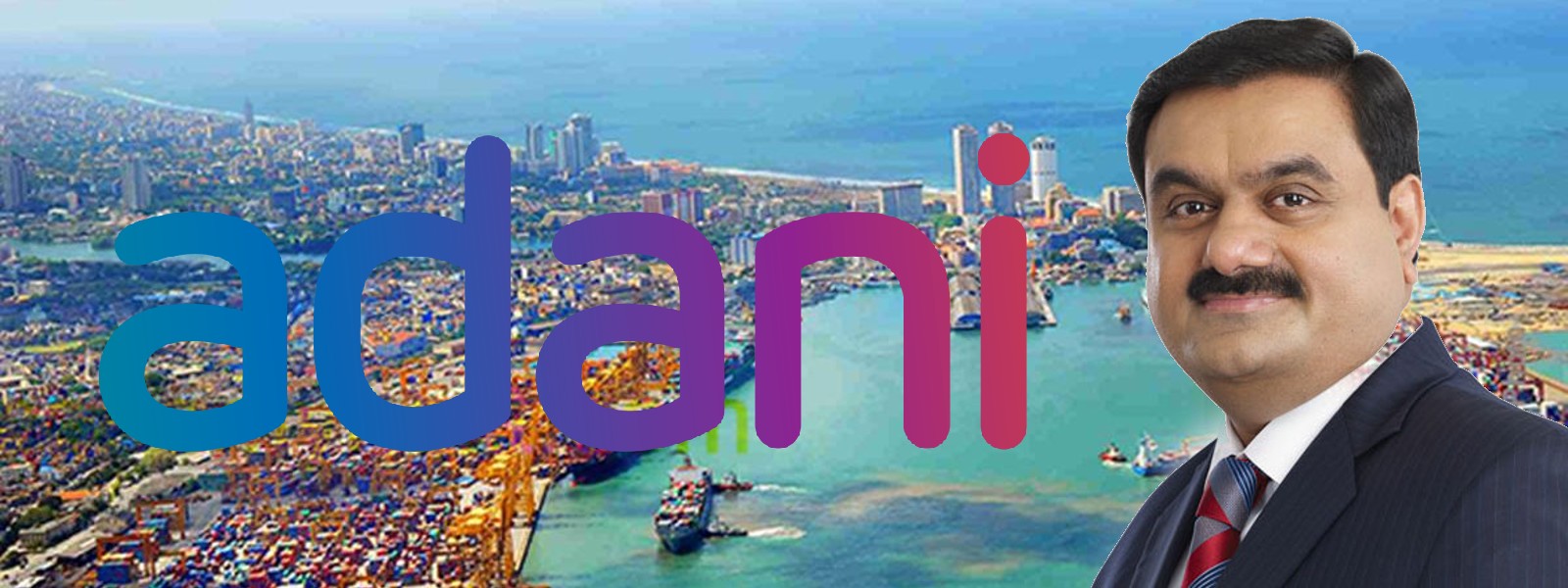Now that India’s Adani Green has withdrawn from the controversial multi-million dollar renewable energy project in the Mannar and Ponneryn, the public discourse over who won and who lost would continue in the formal media and the social media until they find an equally interesting and intriguing subject. The larger question is if, how and how far will if affect the nation’s economy, particularly in the context of President Anura Kumara Dissanayake government’s legacy-approach to attracting foreign investments, which, it is felt, holds the key to the nation’s much-needed and equally delayed big-ticket foreign investments – investments that can create jobs, generate personal incomes and governmental revenue.
That the Adanis’ green energy project in the country was doomed from the start was known to everyone outside the immediate stake-holder circles. There was/is as much politics involved in tying the hands of the otherwise gung-go Indian corporate’s fast-tracked and at times questionable approach to obtaining investment-clearances for their projects, both inside India and outside.
Maybe, they could get away with it nearer home, but not always, elsewhere. Or, that was the perception of the anti-Adani, and at times anti India groups in Sri Lanka. As a section of the social media pointed out early on, the Adanis were seen as using a ‘friendly Centre’ under Prime Minister Narendra Modi, to push their green energy projects to states /provinces ruled by political parties rather than the ruling BJP at the federal-level. That’s to say, the Adanis would be seen as committing to generate and selling power to a central agency, and states would only be signing an agreement with that agency, and not the Adanis, directly.
It was a near-similar approach that they adopted in Sri Lanka, too. First, it was shown as a G2G government-to-government contract, but somewhere down the line, the Indian government slipped in the Adanis in its place. It was the same strategy that was adopted in the case of the promised Indian investment in the strategically-critical $ 700-m Western Container Terminal (WCT) project.
As if to add a local flavour, they brought in John Keells Holdings. Of course, the public sector Sri Lanka Port Authority (SLPA) remained as a substantive stake-holder. Did it make a difference to the progress of the project that is reportedly nearing completion after the initial hiccups to the tri-nation Eastern Container Terminal (ECT) project, in which Japan was also funding partner? It is another matter that port-related trade unions are now charging a shipping company with attempts to ‘take over’ the ECT.
Transparency issues
Where then did the Adanis go wrong with the green energy project, when the general agreement that shortage of fuel, along with food, was at the bottom of the Aragalaya protests in 2022, which had the capacity to overthrow an elected government without anyone shedding any tears and much blood? That is to say, there was neither an insurgent uprising targeting capital Colombo, as was the case with the bloodless mass-uprising. Nor was there any talk of any military coup in the air.
As public documents would show, there were questions of transparency in the matter of the Adanis getting the contract without an open-tender process. True, the Adanis were in a way representing the Indian government, but there were other aspects of the agreement that required a tender process – or so went the argument by Adani-bashers, most of whom were traditional India-bashers in Sri Lankan polity and society.
Then came the power-purchase agreement (PPA). Despite the belated Adani efforts to convince the larger Sri Lankan constituency that they were not at all unfair to the hosts, their effort was too little, too late. Maybe, having come to monopolise markets where they had entered, they obviously did not know public PR goes way beyond ‘managing’ the rulers of the day.
Suffice, thus, to point out how even days after their unilateral announcement at withdrawal from the green energy projects, no political party or leader has commented on the same. Whatever comments, for and against them, has been from domain experts, both professionals and self-styled ones.
Yes, the main SJB political Opposition played its card out in the open when two years or so back, party boss and Leader of the Opposition (LoP) Sajith Premadasa went all the way down to indicate / indict that the Adanis personal relations with Prime Minister Modi was behind the Sri Lankan decision to strike a deal with them. The other two Opposition parties, the SLPP and UNP were the ones who initiated and facilitated the project pact, but they too have not come forward to defend their own decisions.
As far as the ruling JVP-NPP is concerned, did President Dissanayake silently kill the project, as he had also committed to do so in his twin poll campaigns last year? Yes, on record, once in government, the party and the leader only indicated that they would re-negotiate the price with the Adanis and were also appointing two panels to study the project pact and all related matters.
If it was as simple as that, why did the Adanis (have to) quit even before the Supreme Court had begun hearing multiple petitions against the project and project-pact? To be fair to the nation’s highest judicial forum, the verdict could have gone either way. The chances are that the court, once it begins hearing the case, possibly in the coming weeks, might have to come up with a binding verdict in a couple of months.
If still, the Adanis, who point out in their withdrawal-missive to the Board of Investments (BoI) how they had waited for two long years, having held so many discussions and so many more exchanges, had also hit a dead-wall of sorts? Was there any occasion in the past weeks when they were left with the impression that this government would not be defending an institutional commitment of the Sri Lankan State before the Supreme Court, then it was bad policy? Is it going to be the line of governmental submissions before the Supreme Court when the case comes up for regular hearing?
If so, it would have been like the incumbent saying no to the IMF conditionalities being acted upon by the previous government? Again, if it were so, if the Dissanayake dispensation had acted upon the past commitments of the Sri Lankan State to the IMF, the general belief would have been that it would also back such other international commitments – but it might have decided otherwise, or so it would seem.
Walking further or farther
It is not as if the Adanis did not have other issues to address, and which they did not address to the entire satisfaction of other stake-holders, not all of them politically-motivated as one would want to believe. There were the environmentalists who had also moved the Supreme Court, to argue how the wind farms in Mannar would affect the local environment and ecology and make the place inaccessible for annual migratory birds that have been visiting here for generations and centuries.
Then, there was the local population in Mannar, which felt let down, felt offended. If the Adanis or anyone else in India had thought that the war-ravaged population would have concluded that projects like theirs would open up job and development opportunities for the entire Tamil North and more, they seemed to have failed in communicating the same as effectively as they should have.
It is also possible that the investors, like their ‘Sinhala-majority’ hosts did not comprehend the self-righteousness of the Tamil North, or the northern Tamils, when it comes to taking them into confidence and taking their ‘prior approval’ (?) while launching projects of the kind and size. After all, this was the population that had reneged (as much as the Sri Lankan State, so to say) on the Rajiv-Jayewardene Accord of 1987, which aimed at ensuring permanent peace for the war-weary Tamil populace and at the same time ensure a larger, direct role in constitutional administration, which should have satisfied their moderate and militant leaderships – but did not satisfy either.
Suffice to point out how among the petitioners in the Sri Lankan Supreme Court was the Catholic Bishop of Mannar, whose institution has always been active in people-centric issues, starting with the ethnic dispute, war and beyond. There were also other local litigants in the matter, and possibly they might have been satisfied if Adanis’ people had explained to them how the local population too would have stood to benefit. In doing so, whether it was in Mannar or Colombo, the Indian investor should have walked a few more steps further, not farther, as it was being felt, then and since.
It is tempting to compare the Adanis’ handling of Sri Lanka’s green energy projects with another Indian conglomerate, GMR’s approach to the equally controversial ‘Male airport deal’. In both cases, it would seem, the ‘foreign’ investor did not read the public mood and local politics enough, to be able to address concerns that would crop up – real, surreal and imaginary. In both cases, the final outcome was thus not as unpredictable as they turned out to be.
Discourse, debate
Yet, at the end of it all, the Adani pull-out raises more direct questions about what experts would call the ‘investment climate’ in Sri Lanka. First and foremost, both the host government and other stake-holders in the country should acknowledge that foreign direct investor (FDI) is not here to do charity as their governments might have done, one way or the other. They are there to make money, full-stop. If in doing so, they also contribute to the local economy in the best possible way that the locals visualise and approve of, so be it.
The question is if in the name of such visualisation an incumbent government can upturn or upstage what his predecessor(s) had done, all in good faith. Yes, it applies to aspects of the Economic Reforms process that JRJ initiated in the late seventies and much of which are holding good to the present day. In particular, the agriculture sector reforms from that era that has made the country to look elsewhere for food and fertiliser, and also for fruits and dairy products when it had a thriving industry in all these and more, may require a re-visit. If so, that too has to be done in the open, transparently and through multi-layered public discourses, both inside and outside Parliament.
But when the government seems to be upturning a predecessor’s decision in a matter as sensitive as foreign investments that it too believes the country needs, then it should have come upfront and made such announcements that would have been deemed fit for the occasion. At least Adanis’ conduct in withdrawing from the green energy projects, that too when Prime Minister Modi was visiting France and the US, the latter now again under President Donald Trump after a break, the timing becomes as important as their decision – or, doesn’t it?
That Trump has assured Modi that Bangladesh as a neighbour was India’s baby as used to be until before last year’s mass-protests of the Aragalaya kind, may have a message of its own. No, it is not only about the US in the post-Cold War era acknowledging South Asia and the abutting IOR as ‘India’s traditional sphere of influence’. It is also about the greater responsibility that such international approaches confer on India to carry the neighbourhood with it, more than any time in the recent past.
Then, there is the inevitable question about the average Indian perspective in the matter of Adanis’ exit. If there were so many issues that required validation or condemnation by the Supreme Court, how come no one in Sri Lanka had any problem with any of China’s projects, for instance? It started with the Hambantota project, which was controversial in the first place, for every other reason now being cited in the case of the Adanis, including transparency.
Added to that later was the conveyance of the nation’s Hambantota territory to China on a 99-year lease, without anyone challenging the same seriously, either in the public space on in the courts. Even in the case of the later-day Colombo Port City project, the relevant Bill of Parliament alone was forwarded to the Supreme Court for the pre-vote validation, without anyone challenging the very idea of it all – including hidden security concerns in matters fiscal.
It is not just the Adanis or other Indian investors who will be taking stock. In Dubai recently, President Dissanayake invited foreign investments to prop up the nation’s economy – as he should have done under the circumstances. They all have been doing business with India for long, and they all would have also heard of Adanis, for good reasons and bad. Their embassies and existing investors in Sri Lanka would all have been mapping the trajectory of the Adani investments and their final outcome.
Yes, for now, the AKD dispensation, like the last couple of them before it, seems to have drawn a line between the Indian neighbour’s security concerns and Sri Lanka’s very own sovereignty issues that gave it inherent freedom to identify its development partners as it wished. For now, the Adanis, even while continuing with the ECT project in Colombo Port, have also recorded their intention to undertake other projects in the country.
At the bilateral-level, too, the two governments have been enthusiastically discussing defence cooperation. Defence Secretary, retired Air Vice-Marshal Sampath Thuyacontha, held discussions with Indian High Commissioner Santosh Jha recently in Colombo, and followed it up with talks with an Indian team on the side-lines of the Aero India show in Bengaluru. The general take-away is that they are working towards what Prime Minister Modi said was a ‘defence cooperation agreement’ – at the end of his meeting with President Dissanayake in New Delhi in January.
Be it as it may, Dissanayake’s Dubai confabulations, especially the one with former British Prime Minister Tony Blair, raises questions. According to media reports, the two leaders discussed foreign investments particularly in port, tourism and health sectors in Sri Lanka. Blair, incidentally, heads the ‘Institute of Global Change’, which is known as a ‘political influencer’.
There is however no knowing, for instance, whom and how the Institute and its founder have been influencing other nations, their governments and their populations. Is it the USAID way, as some had alluded to a long time ago? If so, does the incumbent government really know what it is ‘running away ‘ (?) from and what it is ‘walking into’ (!)?
In the midst of all this, a civil society group in Mannar has claimed that the government was going ahead with the pricing negotiations with the Adani group next week. If true, it adds a new angle to the entire discourse. But then, the very same civil society group has also come up against the government plans for mineral excavation in Mannar Island, and has threatened to stop a multi-sector departmental committee scheduled to visit the region for an on-the-spot environmental assessment in the coming week(s), as if indicating that the local protest against the Adanis too was/is issue-specific and not otherwise!
(The writer is a Chennai-based Policy Analyst & Political Commentator. Email: sathiyam54@nsathiyamoorthy.com)


